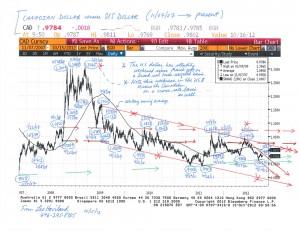As America travels toward Labor Day, it pays to review the nation’s consumer confidence. Assorted measures perform as signposts to assess consumer attitudes and actions. For many, the United States stock marketplace (think of an “overall” benchmark such as the S+P 500) is one. The Conference Board’s United States Consumer Confidence Index is another widely watched indicator. Trends for the United States stock battleground do not precisely mirror those in the Consumer Confidence Index (“CCI”). Weathervanes such as the S+P 500 of course do not derive all their revenues or influences directly from Main Street dwellers or from American sources. The US, as the ongoing worldwide economic crisis that emerged in mid-2007 underscores, intertwines with Europe, China, Japan, and other countries around the globe. However, over the past several decades, there has been a rough link in the major patterns of the S+P 500 and the CCI. And many believe that major trends in US equities tend to parallel those of the American economy as a whole.
Stare at the S+P 500’s extensive ascent from its March 2009 abyss to its current new rally height on 8/21/12 over 1425, particularly the noteworthy stage from the October 2011 depth at 1075. Grandstanders might believe United States consumers generally are rather joyous, or that they soon will become so. The CCI indeed has climbed significantly from its February 2009 valley of 25.3 (the deepest of the 1967-present period). However, the CCI’s subsequent highs around 72.0 (February 2011 and February 2012) lurk far beneath those of 2000 and 2007 (January 2000’s 144.7 and July 2007’s 111.9). July 2012 flutters at a modest 65.9.
Admittedly the US CCI is only one yardstick for consumer confidence and thus to some extent of the strength and duration of economic recovery in America and elsewhere. Maybe sustained higher US equities and at least partial solutions to various troubles facing consumers (including those overseas) will encourage a significant CCI move over 72.0.
However, the feeble rally in the CCI in comparison with the S+P 500 since February 2009, and particularly after autumn 2011, raises significant questions regarding the present and future strength of the American economy (and even of the S+P 500). After all, US consumers are a substantial percentage (around 70 percent) of American GDP. Current US consumer confidence in context warns of economic weakness, or at least sustained sluggishness.
Summer 2012’s recent S+P 500 bull march to new highs over 1425 may continue a while longer. Yet the link between the S+P 500 and “the economy as a whole” is probably notably less than it was a several years ago. But the S+P 500 is not isolated from the economy. So this sustained mediocre (or renewed weakness in) the CCI is ominous for US stocks in general, particularly if other key consumer indicators such as housing, employment, and wages do not soon show substantial strength. Or, suppose there is not major progress on the American fiscal front.
The Gallup News Service recently polled Americans regarding their “confidence” in various “institutions in American society” (June 7-10, 2012). The category created by adding together the answers “great deal” and quite a lot” reveals dispiriting trends and levels that reflect current mediocre consumer confidence levels (as well as the broad erosion in confidence from the January 2000 CCI peak). Relatively weak consumer (Main Street) confidence in several key political and social institutions parallels many worries regarding America’s economic situation.
And anyways, America’s current national deficit and debt situation and its probable near term and long run fiscal prospects justify significant consumer concerns. Moreover, the housing, earnings, unemployment, and household debt factors also help to explain mediocre consumer confidence, both in absolute terms and relative to the S+P 500’s heights.
FOLLOW THE LINK BELOW to download this market essay as a PDF file.
US Consumer Confidence- Many Happy Returns (8-23-12)
US Consumer Confidence Chart (8-23-12)



